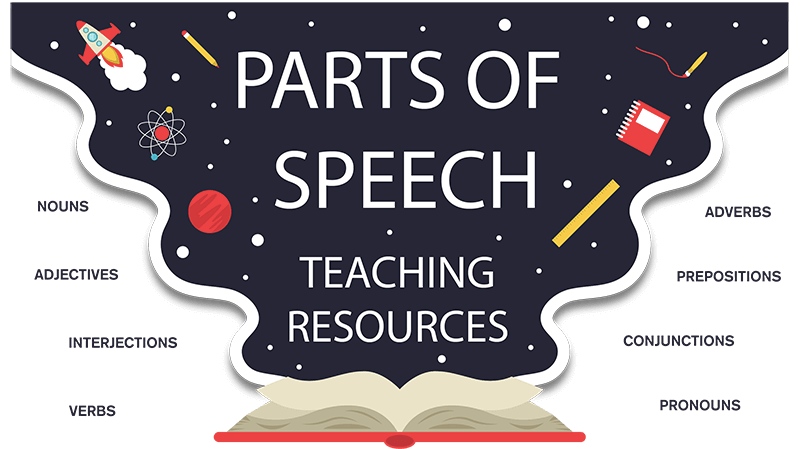Parts of speech refer to the different roles words play in sentences, such as nouns, verbs, adjectives, and others. In this guide on “how to teach parts of speech,” you’ll learn simple, engaging methods to help kids understand each type, making language learning fun and easy. Knowing these basics will help them write and speak more clearly.
Math & ELA | PreK To Grade 5
Kids see fun.
You see real learning outcomes.
Watch your kids fall in love with math & reading through our scientifically designed curriculum.
Parents, try for free Teachers, use for free
What are the 8 Types of Parts of Speech?
| Part of Speech | Definition | Example |
|---|---|---|
| Noun | A word that names a person, place, thing, or idea. | dog, school, happiness |
| Verb | A word that shows an action or state of being. | run, jump, is |
| Adjective | A word that describes a noun or pronoun. | blue, happy, big |
| Adverb | A word that modifies a verb, adjective, or other adverb. | quickly, very, extremely |
| Pronoun | A word that replaces a noun. | he, she, they |
| Preposition | A word that shows a relationship between other words. | under, on, near |
| Conjunction | A word that connects words, phrases, or clauses. | and, but, because |
| Interjection | A word or phrase that expresses emotion. | Wow!, Oh no! |
What is the Best Order to Teach the Parts of Speech?
When teaching the parts of speech, it’s helpful to follow a clear order that builds understanding step by step. Start with the basics, like nouns and verbs, then progress to more complex types. Here’s a simple guide on which ones to teach first.
- Nouns
- Verbs
- Adjectives
- Adverbs
- Pronouns
- Prepositions
- Conjunctions
- Interjections
How to Teach Parts of Speech: 15 Fun Ways
1. Parts of Speech Sorting Worksheets
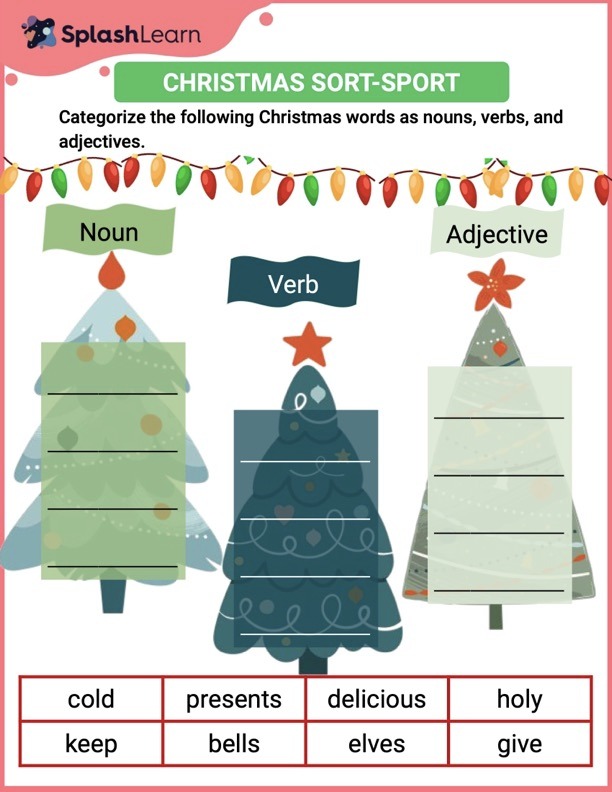
Using worksheets is one of the fun ways to teach parts of speech, such as sorting words into categories. Provide kids with parts of speech sorting worksheet. They’ll categorize each word into the correct part of speech. This activity helps reinforce their understanding of how different words function within sentences.
2. Identify and Color Parts of Speech

This themed worksheet activity offers a creative way to make teaching parts of speech enjoyable. The worksheet features fun designs, like a turkey and Santa, divided into sections representing different examples of parts of speech, such as nouns, verbs, and adjectives. Below the illustration, kids use a color scheme to identify and color each part of speech accurately. It’s a visually engaging and fun way to teach parts of speech that keep kids entertained while reinforcing their understanding of grammar concepts.
Here are fun themed identify and color parts of speech worksheet:
3. Preposition Matching
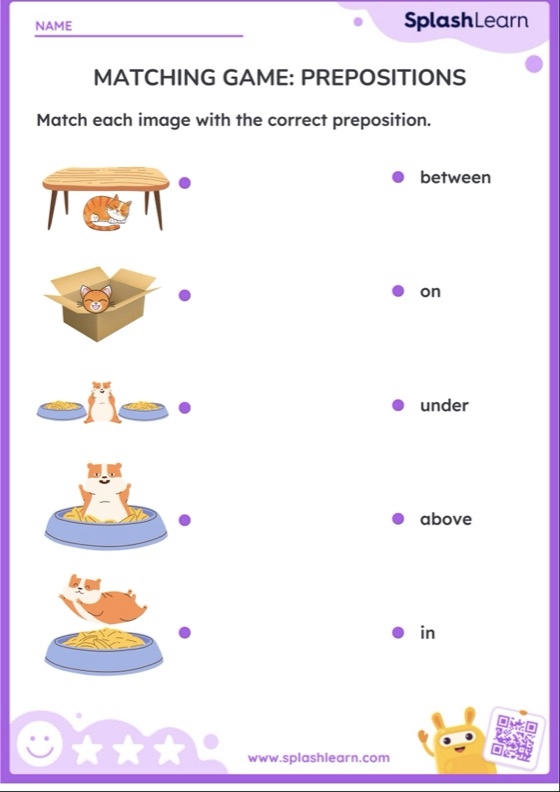
In the preposition matching worksheet, kids will identify the correct prepositions by pairing them with pictures or sentences. They will practice using “in,” “on,” “under,” and other prepositions, reinforcing how these words show the relationship between objects. This fun activity will help them understand prepositions through real-life examples while building their grammar skills.
4. Parts of Speech Mad Libs
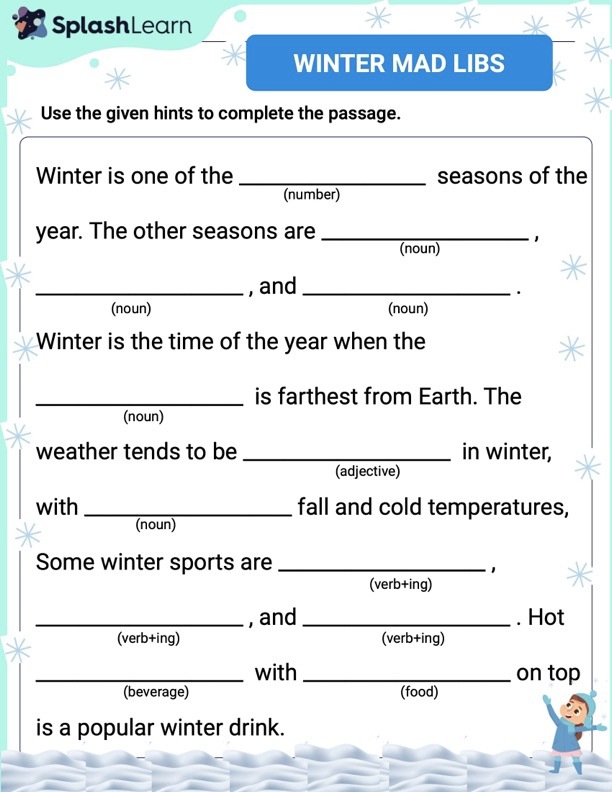
Mad Libs is a playful and imaginative way to reinforce understanding of the parts of speech. Provide kids with fill-in-the-blank stories and ask them to supply words like nouns, verbs, or adjectives in specific places. The result is a fun, silly story that often makes everyone laugh! This activity helps children practice vocabulary in a creative context, letting them see how different parts of speech fit together in sentences.
5. Flashcard Quiz
A flashcard quiz is a handy activity for teaching parts of speech to ESL students and native English speakers alike. Use flashcards with sentences or single words and ask students to identify the parts of speech for kids to understand. You can have them raise a card, give a thumbs up, or call out the right answer. This quick game helps kids reinforce their knowledge while keeping the activity light and engaging.
6. Interjection Worksheet
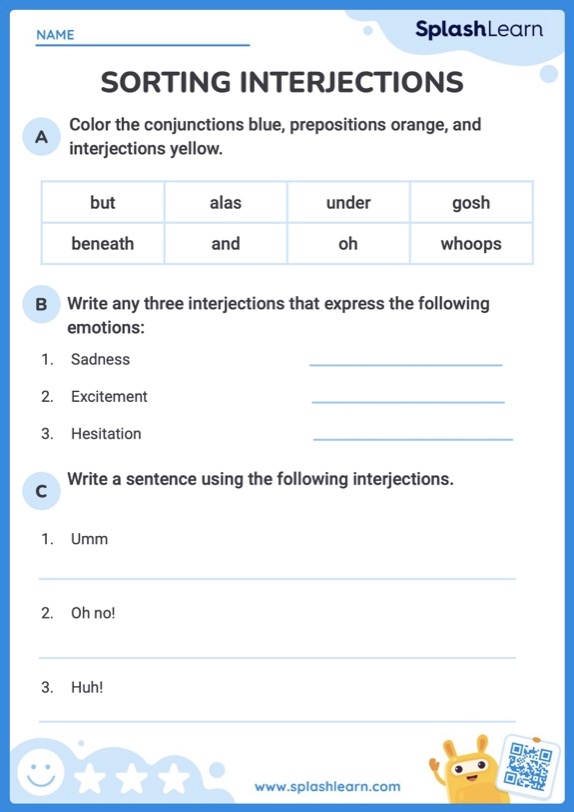
This worksheet introduces kids to interjections in three engaging tasks. First, they’ll identify and color the interjections provided in the worksheet. Next, they’ll write down three interjections that express specific emotions like surprise or excitement. Lastly, they’ll practice using these interjections in complete sentences to understand how they bring emotion and emphasis to writing. This activity helps children recognize and apply interjections in a creative and structured way.
7. Word Search
The word search activity will challenge kids to find various parts of speech, like nouns, verbs, and adjectives, hidden within a word grid. They’ll scan the puzzle to identify and circle the words, reinforcing their understanding of different parts of speech. It’s a playful way for them to practice grammar while sharpening their vocabulary and word recognition skills.
8. Fill in the Blanks
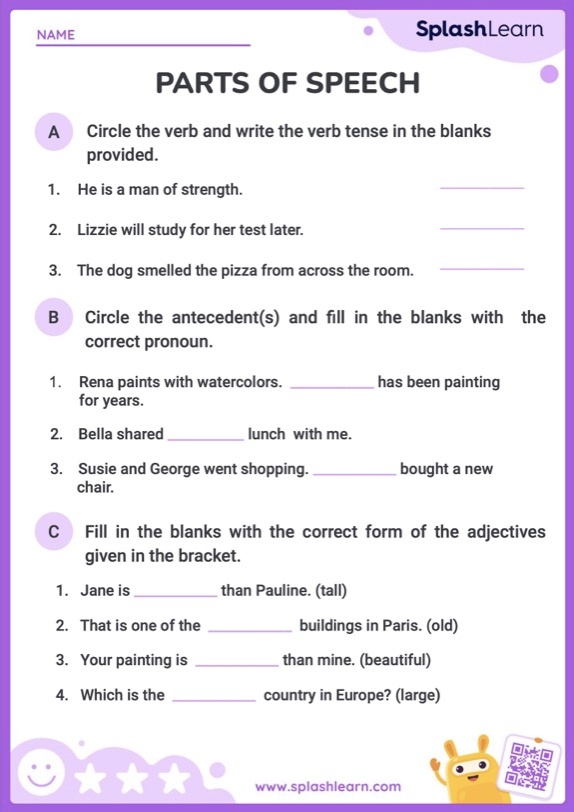
This activity involves giving kids sentences or stories with missing words and asking them to fill in the blanks using appropriate parts of speech. You can focus on different types, such as nouns, verbs, or adjectives. For instance, “The ____ ran quickly,” could be filled with “dog” or “cat.” It helps kids practice choosing the right words and reinforces their understanding of grammar.
Here are some fill-in-the-blank worksheets:
9. Sentence Construction
With sentence construction, give students word cards featuring different parts of speech like nouns, verbs, adjectives, and more. Challenge them to arrange these cards into meaningful sentences that include multiple parts of speech. This activity helps children learn sentence structure, practice vocabulary, and see how each part of speech functions within a complete sentence.
10. Pronoun Substitution
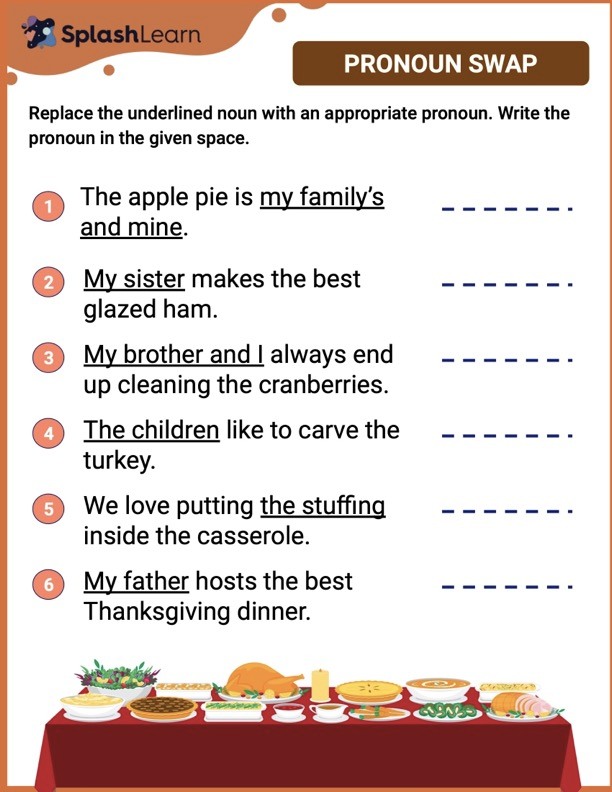
In the pronoun substitution activity, kids replace nouns in a story with suitable pronouns like “he,” “she,” “they,” or “it.” Provide a short story where specific nouns are underlined and let the children rewrite it using appropriate pronouns. This practice helps them see how pronouns can simplify sentences and make writing more fluid.
Here are some fun sentence worksheets to get started:
11. Conjunction Connect
Conjunction Connect is a simple activity where kids practice combining short sentences using conjunctions like “and,” “but,” or “because.” Provide pairs of short sentences that need to be joined, and ask kids to pick the right conjunction to form a single sentence. It’s a great way to teach children how conjunctions help link ideas and improve their writing skills.
12. Grammar Posters
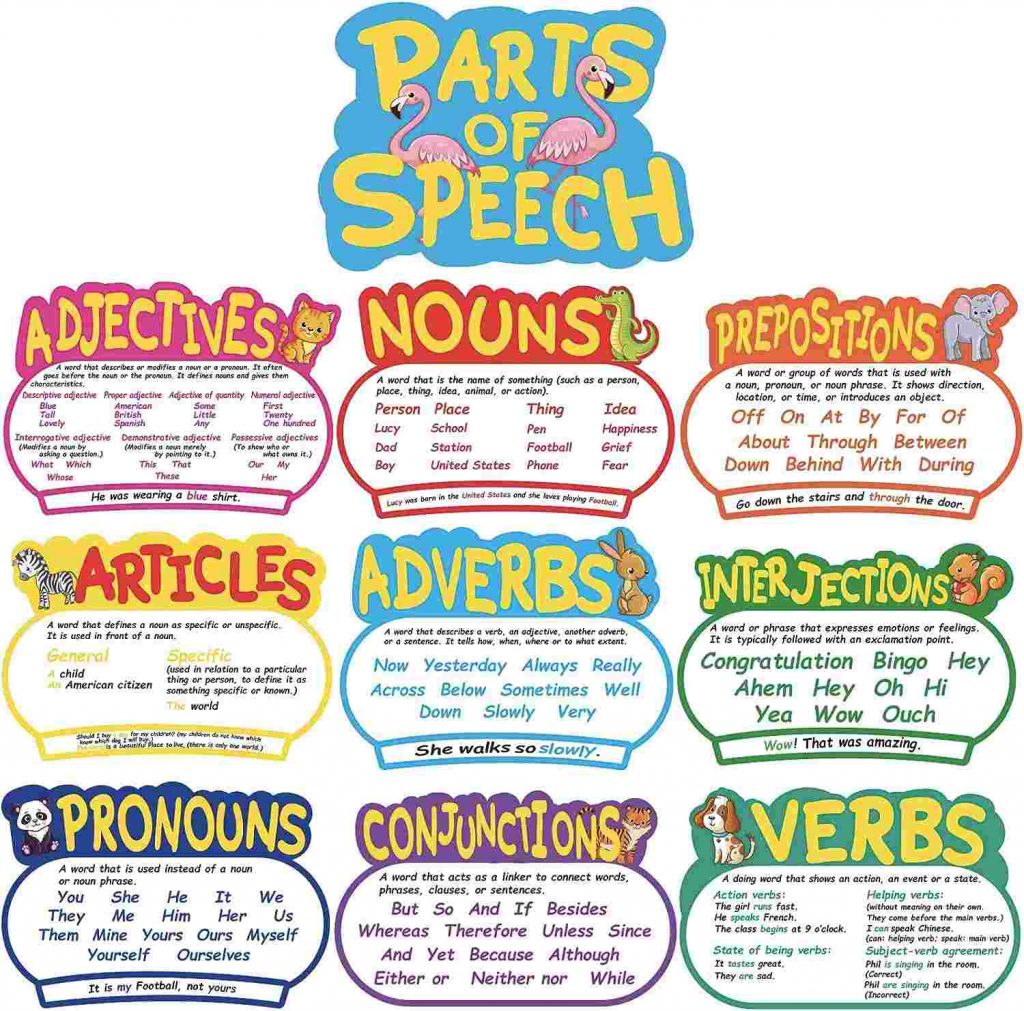
Creating grammar posters is a fantastic way to reinforce the concept of parts of speech for kids. Let them make colorful posters with definitions and examples of nouns, verbs, adjectives, and more. Each poster can focus on one part of speech and include drawings, diagrams, or sentences. It’s a wonderful visual aid for kids, giving them something to reference during their writing or reading practice.
13. Verb Charades
Verb Charades is an interactive and fun way to teach parts of speech, focusing on verbs. Kids act out different verbs while their classmates guess the action. This activity not only makes learning parts of speech active and fun but also helps children understand verbs as action words. It’s a great way to physically engage students in learning and reinforce their understanding through movement and interaction.
14. Parts of Speech Bingo

Turn identifying parts of speech into a game with Parts of Speech Bingo. Create bingo cards with different words representing each part of speech. As you call out a word, students will mark their cards under the correct category, like “noun” or “verb.” This game adds a playful twist to grammar lessons while reinforcing the kids’ ability to categorize different words accurately.
15. Interjection Role-Play
Interjection Role-Play helps children grasp how interjections add emotion to sentences. Create scenarios where kids take turns acting out situations, using interjections like “Wow!” for excitement or “Oh no!” for surprise. You can offer prompts like receiving a gift or finding a missing toy to encourage genuine expressions. This fun activity allows kids to practice using interjections naturally in conversations, boosting their confidence and creativity with language.
Conclusion
Understanding how to teach parts of speech is essential for helping kids communicate clearly and confidently. By following a structured approach, kids will develop strong language skills that support them in reading, writing, and everyday conversations.
Related Reading: Easy Steps to Improve Writing Skills for Kids

















